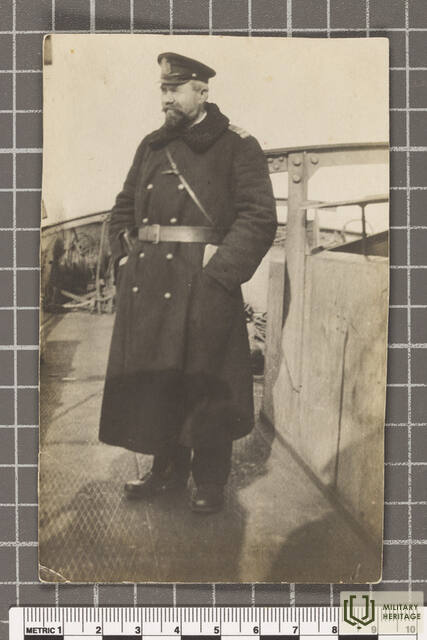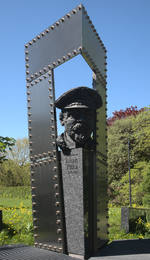Johanas Pitka (1872–1944 m. rudens)
I Nepriklausomybės karai, II Antrasis pasaulinis karas
Estijos karinio jūrų laivyno karininkas ir politikas, vienas iš Estijos Respublikos įkūrėjų ir vienas legendinių Nepriklausomybės karo vadų. Jis buvo vienas iš Estijos karinių jūrų pajėgų, Gynybos lygos ir Pasienio apsaugos įkūrėjų, Nepriklausomybės kare pradėjęs naudoti šarvuotus traukinius ir automobilius. Laisvės kryžiaus 1-osios klasės 1-ojo rango kavalierius.
Pitka gimė 1872 m. vasario 19 d. Jervos apskrityje. Jis lankė jūrų akademijas Kesmu, Kuresarėje ir Paldiski, o 1895 m. įgijo jūrininko meistro kvalifikaciją. Nuo 1917 m. jis aktyviai prisidėjo prie Estijos nacionalinių karinių dalinių formavimo. Pitka buvo Estijos karių pagrindinio komiteto narys ir už tai bolševikų buvo nuteistas mirties bausme. Nuo 1917 m. rugsėjo mėn. jis įkūrė Talino namų gvardiją, kuri vėliau išaugo į Gynybos lygą. Nepriklausomybės karo pradžioje jis vadovavo jūrų pajėgų ir šarvuočių dalinių formavimui. 1918 m. gruodį jis buvo paskirtas Estijos Respublikos jūrų pajėgų vyriausiuoju vadu, vadovavo visoms Estijos jūrų operacijoms Nepriklausomybės karo metu ir 1919 m. buvo paaukštintas į kontradmirolo laipsnį. Aktyviąją tarnybą jis paliko 1919 m. lapkritį.
Vėliau Pitka įsitraukė į politiką ir aktyviai dalyvavo verslo pasaulyje, nuo 1924 iki 1930 m. gyveno Kanadoje. Grįžęs į Estiją, jis prisijungė prie Nepriklausomybės karo veteranų judėjimo. Estijai patekus į sovietų valdžios rankas, Pitka 1940 m. rugpjūtį pabėgo į Suomiją.
1944 m. pavasarį jis grįžo į tėvynę ir bandė organizuoti nacionalinį ginkluotą pasipriešinimą, kad apgintų Estiją nuo įsiveržiančios Raudonosios armijos. Rugpjūtį, gavęs vokiečių leidimą, jis suformavo bataliono dydžio smogiamųjų pajėgų komandą, pavadintą „Admiral Pitka“, kuri nebuvo pavaldi vokiečių karinei vadovybei. „Pitkos berniukai“ kovojo su Raudonąja armija Harju ir Lääne apskrityse, vokiečiams pasitraukus iš Estijos. 1944 m. rugsėjį Pitka dingo be žinios mūšio lauke; jo mirties aplinkybės ir laidojimo vieta iki šiol nežinomos.
Johanas Pitka buvo vedęs Helene Neuhaus. Keturi sūnūs ir dvi dukros sulaukė pilnametystės. Jonas žuvo autoavarijoje 1923 m., Oliveris-Edwardas ir Stanley buvo sušaudyti koncentracijos stovykloje Solikamske, Augustas-Andreas – Butyrkų kalėjime Rusijoje. Helene ir jos dukros pabėgo į Kanadą.
Susijusios vietos
Johano Pitkos atminimo ženklas
Šis Johano Pitkos memorialas yra Vismari gatvėje Taline. Paminklas, kuriame pavaizduota skulptoriaus Tõnu Maarando sukurta bronzinė admirolo galva, buvo atidengtas 2002 m. vasario 19 d., dalyvaujant prezidentui Lennartui Meri ir Talino merui Edgarui Savisaarui. Vėliau buvo pridėtas architekto Marto Kadariko suprojektuotas pajuodęs plieninis pleištas, primenantis laivo priekį. Kaip vėliau pabrėžė Kadarik, pleištas nukreiptas į rytus ir simbolizuoja, kur nukreiptos pagrindinės Estijos gynėjų pastangos. Po statula yra trikampis suvirintas grotelių paviršius, simbolizuojantis laivo denį. Po grotelėmis paminklą apšviečia mėlynos šviesos, simbolizuojančios glaudų Pitkos ryšį su jūra ir Estijos jūrų sienų apsauga.







